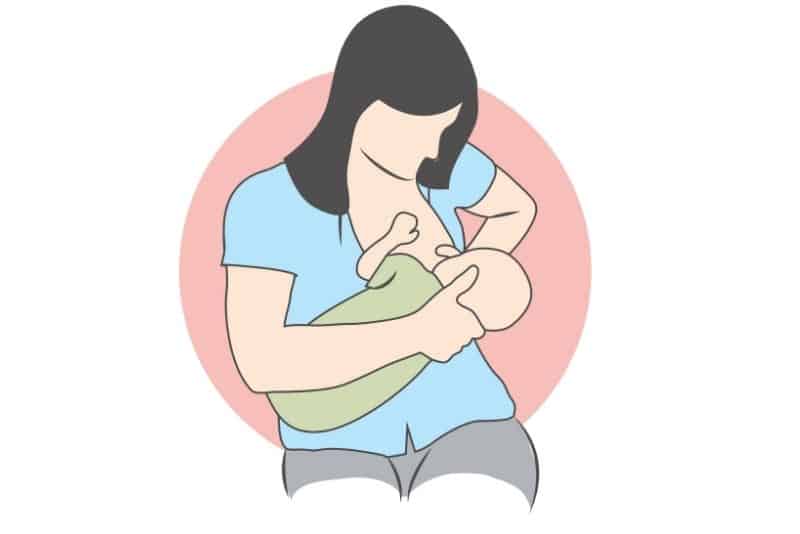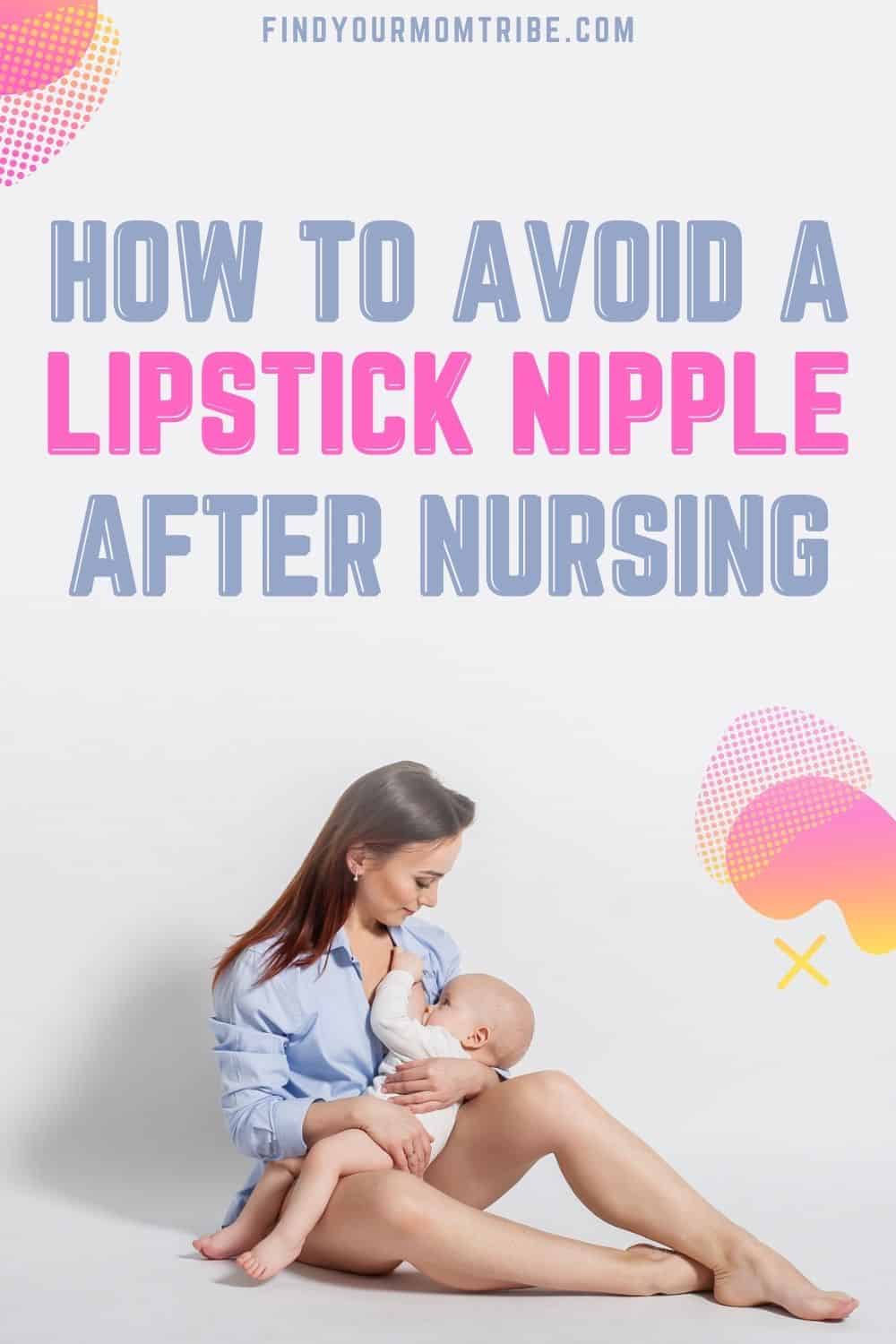Breastfeeding is part of almost every new mom’s routine. It’s a process that’s relatively straightforward once you get used to it, but it does have its challenges. One of these challenges is getting a lipstick nipple after nursing.
A lipstick nipple after nursing isn’t all that uncommon. First-time moms are more likely to experience it, but even veteran moms encounter it every now and then.
It occurs when the baby’s mouth isn’t positioned correctly and he struggles to get a good latch, leaving one side of the nipple slanted like the tip of a tube of lipstick, hence the name.
While it’s not a super serious condition, it can certainly cause quite a few temporary problems for you and your child.
For moms, it’s usually dealing with cracked or sore nipples and nipple pain in general. This can then lead to issues with breast milk supply which has a different set of problems altogether.
It’s a bit worse for babies as a bad latch might lead to a general failure to thrive which then leads to a decreased growth rate, something that can have harsher consequences later down the line.
Either way, a shallow latch means problems for both mom and baby, leading to the aforementioned nipple pain for you and, for your child, it makes it a lot harder for him to get a deeper latch in the future.
When a new mom’s nipple resembles the head of a brand new lipstick, it can cause serious panic. Read on to find out more about the issues linked to this scenario, as well as ways to remedy the situation before any complications develop.
What Does It Mean To Get A Lipstick Nipple After Nursing?

A key focus area of any parenting class is the importance of a baby’s latch during the breastfeeding period.
Getting a case of the lipstick nipple during that time means that the latch itself was poor and it needs to be adjusted.
A proper latch is a deep latch, and maintaining it can help minimize a lot of potential issues for both you and the baby.
It’ll help empty the breast easier and reduce the amount of nursing pain as well as the risk of mastitis or similar breast problems such as an imbalance of foremilk and hindmilk.
For the child, latching well helps keep him fed properly, sated, content, and, most importantly, less fussy after a feed.
However, should the child have a poor latch, it can lead to a whole number of problems, some relatively harmless, others a lot less so.
There are a number of potential issues that can arise for both you and your baby such as:
• A delay in the child’s growth
• Mastitis
• Imbalance of hindmilk and foremilk
• Sore, cracked, or even bleeding nipples
• General nipple pain
• A general failure to thrive for the child
• Lower weight gain or even weight loss for the baby
• Overall insufficient milk supply for the mother
• Blanching (the nipple turning white due to a blood circulation cutoff)
• Thrush
• Blisters around the nipple
• Elongated nipples
• Droopier nipples
You would think that something as simple as a slightly malformed nipple wouldn’t be capable of causing so many problems, but there’s always the possibility of these random occurrences building on one another and then leading to these difficult situations.
A special note about blanching is that if you start seeing and/or feeling the symptoms of it, it’s worth going in for a checkup as these vasospasms could be a sign of Raynaud’s disease and actually be completely unrelated to lipstick nipple.
How To Fix A Lipstick Nipple

The main cause of lipstick nipples after breastfeeding is a bad latch, and, as such, it’s the first thing that you’ll need to address in order to remedy the situation.
A baby needs a deep, well-positioned latch on the boob to be able to breastfeed properly. The best way to go about that is to find the right position for your child.
1. Make sure to keep the baby’s head still and assume the right position
The first thing that you want to do is make sure that the baby’s head is fully supported with your arm keeping his head steady so there’s little to no swerve or bobbing.
The ideal position is usually to place your hand at the base of the head with the fingers cupping the back of his skull gently while the palm supports his shoulder area and nudges him forward.
This way you can control the facing with minimal effort while providing maximum comfort for your child. Keep the rest of his body resting on you so he has a comfy seat.
If you’re still struggling to figure it out, this is known as the cross-cradle position and is the one most commonly used in breastfeeding. A visual is likely to be of better assistance:

2. Make the breast easier to access
Next up, you want to cup your breast with your other free hand, form a crescent shape with the thumb and the rest of the fingers and wrap it around your breast.
But keep the fingers away from the nipple, make sure it stays in its natural shape. It’ll only make it difficult for the baby to get that deep latch otherwise.
3. Make adjustments until a comfortable position is achieved
The next step is to position the baby accordingly with his neck craned upwards ever so slightly.
Make sure that the baby’s nose is aimed a bit above the nipple. Many new moms don’t pick this trick up at the start as it takes a bit of experience, but there’s a little lifehack for you if you’re having trouble finding the right spot.
This method will also trigger an instinctual response in your little one and he’ll immediately open his mouth. Make sure he opens it wide enough for him to be able to envelop the entire nipple and areola.
After that, just angle the breast so it’s pointing at the roof of your baby’s mouth and let him do the rest.
4. Check in from time to time
If everything was done properly, your baby should be latched on and happily sucking away.
But do check in periodically just in case your little rascal decides to shift his position or pull away from the breast.
How Will You Know If Your Baby Has Latched On Well?

Unfortunately, helping your baby get a good latch sounds easier than it actually is. It takes time and practice to get it right.
That said, once you do get the hang of it, it’ll become second nature to you.
One of the best ways to know that your child has a good, deep latch is if his head is craned upwards slightly to the point where his chin is pressing lightly against your breast.
It’s a subtle sign, but one of the main signs of a good latch.
Another good sign is if his nose is only gently grazing against your breast and not completely squished in. He needs to breathe and if his mouth is occupied, his nose is the only other way to do so.
If it’s blocked in any way, the position is not good.
Finally, keep in mind that the distance of the bottom and top lip from the base of the nipple matters.
The top lip should be closer to it than the bottom lip so the breast milk doesn’t go directly to his throat, but hits the roof and washes around it. This helps reduce the risk of choking.
As you can see, these are not exactly the easiest signs to spot, but with a little bit of practice, you’ll manage to avoid having your nipple look like the end of a tube of lipstick.
What To Do In Case Of Complications
You might not be able to avoid getting a lipstick nipple every time so it’s important to know how to deal with the potential complications caused by your sweet baby’s lips being in an improper position for a long time.
1. Consult a lactation consultant

If the complication is affecting you or is indirectly caused by some underlying issue, it’s best to immediately schedule an appointment with an international board-certified lactation consultant (IBCLC) to get to the root of the problem and figure out how to remedy it.
This is especially true for severe instances of breast and nipple pain.
They’ll be able to better diagnose what the root cause is and determine how to fix it. Remember that their advice always comes first in cases like these.
2. Wear a nipple shield
If you’re having trouble with breast compressions with the aforementioned method, you can try using a nipple shield instead.
It helps alleviate some pressure from the baby’s mouth on your breast.
It also allows it to heal if it’s sore or cracked and helps protect it from chafing when you’re being a bit more active.
Do note that this is only a temporary measure until you manage to get rid of the lipstick nipple.
3. Consult your child’s pediatrician
If it’s not your breast that’s being affected here, but rather your child, then you might need to prioritize a visit to the pediatrician to help diagnose your baby and see what’s causing these issues.
There are certain genetic factors that can affect your child’s ability to latch that aren’t anyone’s fault. Things that will either go away on their own or might even need corrective surgery such as a lip tie or a tongue tie.
Both of these will prevent your child from creating the necessary pressure to suck the breast milk out. Instead, it ends up getting squeezed which puts more strain on the nipple itself and causes lipstick nipple after nursing.
4. Use a breast pump
If your child is having issues latching properly and getting enough milk which, in turn, causes more problems for both you and him, then you may need to consider swapping over to pumping.
I know that a good number of mothers prefer exclusive breastfeeding over using machines, but if the problem isn’t going away, it might be a necessary step in order to provide your child with the proper nourishment and your breasts with some relief.
You can try it for at least a little while until the problem clears itself up.
If anything, try alternating and see if that helps.
The type of pump doesn’t really matter either, you can go for either a manual or electric breast pump – they each have their pros and cons. Just take one that you think may work better for you.
Other Things You Should Know

As already mentioned above, the method that’s crucial to always providing a good breastfeeding session is the U-shape (also known as a C-shape or a crescent shape) method of breast compression that allows for an easier latch for your child.
Simply form the shape of the letter with your thumb and your remaining fingers and cup your breast, but keep them away from the nipple, allowing better surface area for the baby to latch onto and suckle.
The other method that helps calm the baby down and create a soothing nursing environment that’s helpful for a good latch is plenty of skin-to-skin contact.
Being directly in contact with familiar warmth relaxes the baby, making the whole breastfeeding session a lot easier to complete with a lot less fuss.
Obviously, this isn’t always possible, but try doing it as often as you can.
Finally, there’s the flipple technique which involves taking the breast and pointing the nipple upward, toward the baby’s upper lip to angle it in a way where a good part of the areola is in the child’s mouth.
Make sure that the baby’s lips are curled outward for maximum comfort and the ideal position.
Finally, it’s worth noting that at the start, at least if you’re a new mom, your nipples will be quite sensitive for a large chunk of the first week.
This might feel like a side-effect of lipstick nipple after nursing, but it’s just a temporary agitation that should go away as you and your newborn adapt to nursing.
It usually flares up during breastfeeding sessions then goes away, so it’s nothing to be worried about.
In Conclusion

Having to deal with the appearance of a lipstick nipple after nursing can be a hassle, but if dealt with properly and early, it shouldn’t cause too much trouble for you.
However, it’s important to not pretend as though you’re not having issues. Don’t be afraid to see your pediatrician or lactation consultant if you’re struggling and find that nothing is working.
Their job is to help you out and their advice should be heeded if you’re looking for the best way to remedy a given situation.
Outside of that, the key to avoiding the issues of a lipstick nipple after nursing is to maintain a proper latch during breastfeeding by lifting the baby’s chin up and having the nipple angled upward, toward the roof of his mouth.
A good position for the baby is just as important, and the cross-cradle position is often recommended as it’s the staple of breastfeeding mothers everywhere.
Finally, remember that nursing is an acquired skill for both the mother and the baby, so don’t feel guilty if it takes some time to understand what works for you.
Like this post? Please share or pin it for later. You can also stay in the loop and follow us on Facebook, Instagram or Pinterest.

We love honesty! Find Your Mom Tribe is an Amazon Associate and we earn from qualifying purchases through affiliate links at no extra cost to you. Please see our full Amazon Affiliate disclosure for more information.

